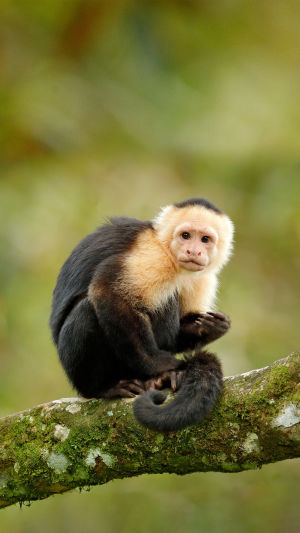White-faced capuchin monkeys, a species of the genus Capuchin in the family of the same name, are native to the neotropics of Central America.
The species can be found in Honduras, Nicaragua, Costa Rica, Panama, Ecuador, and Gorgona Island in Colombia, making it one of the most widespread New World monkeys.
White-faced capuchins exhibit a high degree of dimorphism, with males weighing between 3-4 kg and females weighing between 2-3 kg. This species is easily distinguishable from other capuchins due to its unique markings. The back and hindquarters are black, while the fur on the chest, forearms, and face is white.
The cheeks are tan, and a black "hat" sits on top of the head. The species is known for its curly tail, which helps the monkeys to grip and carry food, as well as maintain postural support.
White-faced capuchins reach adulthood at the age of 8. They are primarily quadrupedal animals, but they are also excellent climbers and jumpers.
White-faced capuchins are adaptable primates and can thrive in a wide range of habitats. They can be found in a variety of wet and dry forests, including tropical evergreen and dry deciduous forests.
They prefer dense forests that are up to 2100 meters high, with the majority residing at around 1100 meters. They are most commonly found in lowland areas with high humidity and good drainage, but they can also be seen in volcanic foothills and coastal plains.
The habitat of a white-faced capuchin is about 80 hectares (0.8 square kilometers), and they are territorial, defending their space from other capuchins. When an intruder is detected, the individuals will sound an alarm and either flee or swarm to attack.
White-faced capuchins are social animals, and communication plays a crucial role in their lives. They spend a lot of time building trust and making social connections, such as hand sniffing and sucking on each other's fingers and tails.
They also play mouth games, where they insert objects into their mouths and try to pry them out of each other's mouths. These activities are done in turns and can last for several minutes.
In the event of a predator approach, white-faced capuchins use trill vocalizations to coordinate their movement as a group. Different alarm calls are used to alert other monkeys to nearby predators or intruders.
The white-faced capuchin's diet is diverse, consisting of a wide range of fruits, nuts, insects, invertebrates, and small vertebrates such as squirrels, tree mice, lizards, and birds. The exact composition of their diet varies by region and season, but it is usually made up of 50-80% fruit, 20-30% animal ingredients, and 10% other plant ingredients.
White-faced capuchins are adventurous eaters and will try almost anything, learning through trial and error what is edible and desirable. One study showed that white-faced capuchins ate 63 different plants from 34 families in Santa Rosa Park.
These primates are excellent foragers from a young age, with young ones able to find food almost as well as adults by the time they are one year old. The only limitations they face are size and strength.
The white-faced capuchin is a unique and fascinating species that is widely distributed in Central America. With its distinctive markings and playful behavior, this primate is a true gem of the neotropics.





